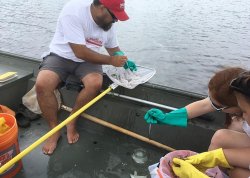Cling and Sting: Tiny jellyfish a big hazard in South County ponds, river
Professor Paul Bologna, accompanied by two students, took a trip up to Rhode Island to collect samples and data of the invasive jellyfish now in the area.
Posted in: In the Media, Marine Biology, Our Research

Using hand-held dip nets, three researchers from Montclair State University, in New Jersey, pulled as many as two dozen jellies at a time from the eastern half of Potter Pond near Meadow Point as they drifted over the eelgrass beds that offer them shelter during the day and serve as feeding grounds for them at night.
“This is an incredible abundance,” Paul Bologna, director of the Marine Biology and Coastal Sciences Program at Montclair State, said after his team filled three large containers with the dime-sized, near-transparent jellies to take back to their lab.
Native to the northern Pacific Ocean, clinging jellyfish, Gonionemus vertens, first showed up in New England in 1894 when scientists found them in Woods Hole, Massachusetts. They may have come in ballast water or as polyps — an early stage in the animal’s life cycle — attached to ship hulls. They were soon spotted elsewhere around Cape Cod and in Groton, Connecticut.
The animals all but disappeared from the region in the 1930s when a wasting disease wiped out nearly all the eelgrass beds on the Atlantic Coast, but in 1990 swimmers on Cape Cod reported being stung by them. The jelly has since spread to New Jersey, Long Island and New Hampshire and, over the past three years, more stings have followed. In the most severe cases, victims have suffered difficulty breathing, debilitating pain and even temporary neurological impairment.
The first stings to be reported in Rhode Island occurred last summer. Three people ended up in the emergency room after coming into contact with the jellies in Potter Pond and Point Judith Pond. The jelly was also found last year in the Narrow River, in Narragansett. And this summer, Katie Rodrigue, principal biologist with the Rhode Island Department of Environmental Management, has spotted them during fish surveys in Ninigret Pond in Charlestown, too.
“We pulled in at least a dozen of them,” she said.
Read the full article on the Providence Journal’s website!
